0 Preface
A new generation of green environmental protection light source represented by LED has been gradually popularized and applied in recent years, and people's requirements for efficient control, diversification and individualization of LED lighting are also increasing. How to create a light environment corresponding to a specific scene according to user needs, improve lighting efficiency and reduce energy waste is an important part of LED intelligent control system research.
Communication is an important part of the LED intelligent control system. At present, there are traditional light sources or LED lighting control systems using wired network technologies such as DALI, C-Bus, DMX512, Ethernet, and wireless network technologies such as ZigBee and GPRS. However, the LED control system based on the above communication method is in the control protocol. There are certain deficiencies in terms of openness, data transmission reliability, security, equipment hardware costs, and operating costs. RF4CE is an RF remote control standard for the home appliance industry jointly proposed by the ZigBee Alliance and the RF4CE Alliance in 2009. Its goal is to eventually replace the widely used infrared remote control technology. RF4CE is a network layer and application layer protocol based on IEEE802.15.4 physical layer and MAC layer. It has non-line-of-sight transmission, two-way communication, ultra-low power consumption, good interoperability, and free ISM frequency band. It can be used as home automation. An important wireless communication platform for entertainment applications.
In view of the shortcomings of the existing LED lighting control system, this project designed a set of interactive, reliable, economical and practical LED intelligent lighting system based on RF4CE RF remote control standard, which can pass the LED lighting system for home and public places. Network control, to achieve the various lighting environments that users expect, and to achieve energy saving and consumption reduction.
1 overall system structure
The LED lighting control system consists of a remote control and a high-power LED dimmer. Both sides are connected wirelessly through the CC2530 module with built-in RF4CE protocol. Figure 1 shows the device structure of the LED control system. The user inputs the control command by using the remote control button, and the command is sent to the dimmer in the form of a data packet conforming to the RF4CE protocol. The dimmer generates three sets of PWM outputs of R, G, and B according to the command requirements, combined with the current working state, and controls the red, The power of three high-power LED lights, green and blue, forms the desired light intensity or color temperature effect. The EEPROM in the dimmer is used to store the PWM sequence (ie recipe table) for the particular lighting effect.

Figure 1 LED control system equipment structure
2 hardware circuit
Figure 2 shows the hardware schematic of the remote control main control circuit. The remote control uses the STC89C52 as the main controller, and the peripheral includes 8 operation buttons and 1 status indicator. The STC89C52 is connected in series with the CC2530 module. To save power, the STC89C52 and CC2530 are normally in a sleep state. When any of the 8 buttons is pressed, in addition to causing the corresponding port line in the P2 port to be low, an external interrupt is generated by the conduction of the corresponding diode. The MCU wakes up from sleep and immediately sends the key value corresponding to the button. CC2530 uses the serial port interrupt to wake up, and sends the key value sent by the master microcontroller to the LED dimmer in time.
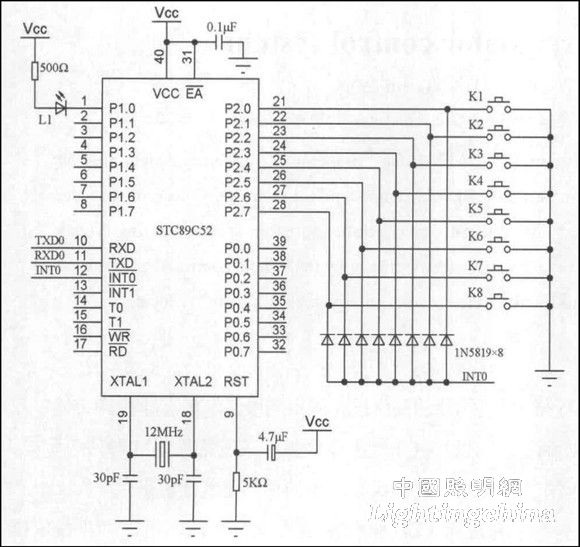
Figure 2 remote control main control circuit
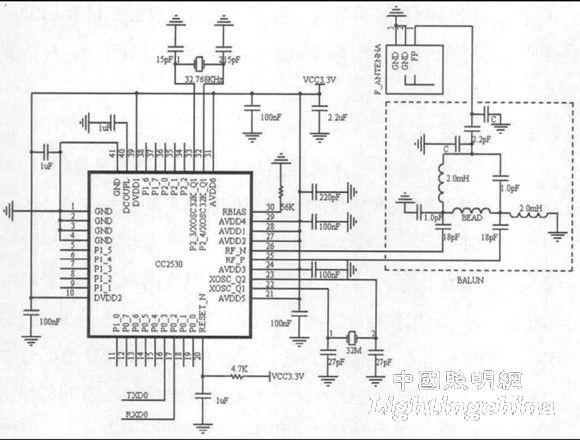
Figure 3 RF interface circuit
Figure 3 shows the hardware schematic of the CC2530 module. The CC2530 in the figure is a wireless SoC chip from TI. It integrates an 80C51 microprocessor, an IEEE 802.15.4 RF transceiver, a large-capacity memory and a rich interface component. It can be easily implemented by loading the ZigBee and RF4CE protocol stacks. Typical application based on two protocols. The CC2530 requires only a small number of peripheral components. Among them, the antenna section has a great influence on the wireless communication performance. Therefore, component selection and PCB plate making must strictly comply with the precautions in the manual.
Figure 4 shows the hardware schematic of the dimmer's main control circuit. In order to generate independent 3-channel high-frequency PWM, the single-clock cycle enhanced 51-core single-chip STC12C5410AD is used, and the working speed under the same crystal condition is 8~12 times faster than that of the ordinary 51 single-chip microcomputer. The STC12C5410AD and CC2530 modules are also connected in series. The three PWM outputs are connected to the PWM dimming inputs of the R, G, and B LED drivers. The AT24C64 is an 8-Kbyte serial EEPROM memory that is connected to the virtual I2C interface of the microcontroller via SCL and SDA for storing the scene recipe table.
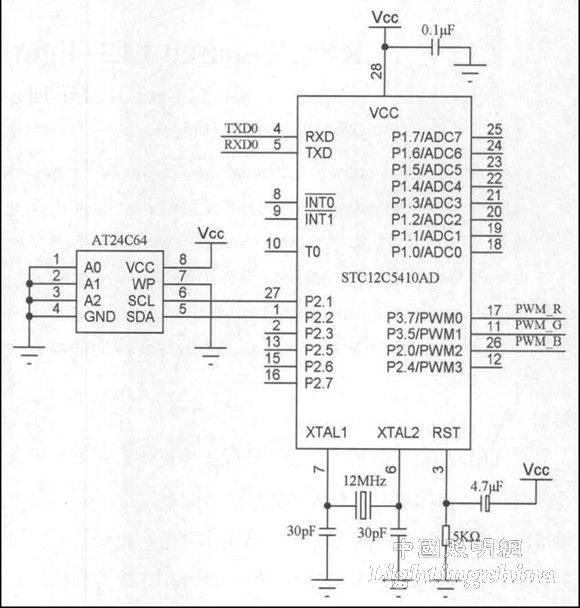
Figure 4 Dimmer main control circuit
Table 1 lists the storage structure of the scene recipe table. Each table includes start and end flags that are logically recorded as the base time (unit: s) for each PWM combination.
Table 1 Recipe table data storage format
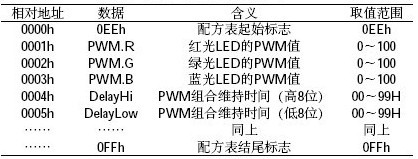
Figure 5 shows the hardware structure of the LED driver circuit. In Figure 5, the LT3756 is a new high-power LED driver chip with an input voltage of 6 to 100 V. An external N-channel MOSFET can drive 20 1 A white LEDs with a nominal 12 V input, with an efficiency of over 94. %, the frequency range is from 100 kHz to 1 MHz. The LT3756 features True Color PWM dimming with a dimming range of up to 3,000:1.
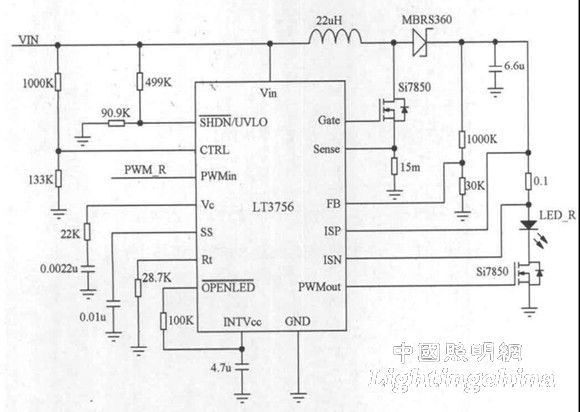
Figure 5 LED drive circuit
3 software process
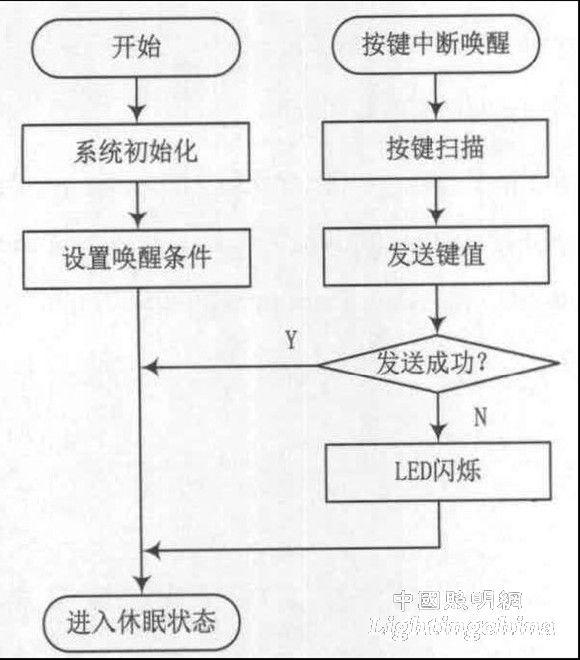
Figure 6 remote control main control program flow chart
The main control program flow of the system remote control is shown in Figure 6. The wireless remote control system essentially extends the receiver's local input device wirelessly, so the main task of the remote control program is to detect keys and send key values. The low-average power consumption of the microcontroller can be achieved by using the sleep-interrupt mechanism.
Compared with infrared remote control, RF4CE has a very important advantage. It is two-way communication. After the remote controller issues the key value, it can control the status indicator to turn on and off according to whether there is correct response information, thus reminding the user to perform correct operation.
4 Conclusion
After actual measurement, the LED lighting control system can achieve the required functions, the remote control distance is not less than 30 m (open ground), and the average current of the remote control is less than 10 μA. This system uses the latest RF remote control technology RF4CE for LED lighting control, thus overcoming the existing openness, reliability, safety, interoperability, equipment and operating costs of DALI, C-Bus and other lighting control systems. Insufficient, it can realize the intelligent regulation of LED lighting system with high cost performance, and improve the efficiency of electric energy utilization.
Edit: Cedar
Home Energy Storage,Bicycle Lithium Battery,Electric Bicycle Battery,Electric Bicycle Lithium Battery Pack
Sichuan Liwang New Energy Technology Co. , https://www.myliwang.com